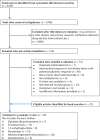Potential Markers of Dietary Glycemic Exposures for Sustained Dietary Interventions in Populations without Diabetes
- PMID: 32449931
- PMCID: PMC7490172
- DOI: 10.1093/advances/nmaa058
Potential Markers of Dietary Glycemic Exposures for Sustained Dietary Interventions in Populations without Diabetes
Abstract
There is considerable interest in dietary and other approaches to maintaining blood glucose concentrations within the normal range and minimizing exposure to postprandial hyperglycemic excursions. The accepted marker to evaluate the sustained maintenance of normal blood glucose concentrations is glycated hemoglobin A1c (HbA1c). However, although this is used in clinical practice to monitor glycemic control in patients with diabetes, it has a number of drawbacks as a marker of efficacy of dietary interventions that might beneficially affect glycemic control in people without diabetes. Other markers that reflect shorter-term glycemic exposures have been studied and proposed, but consensus on the use and relevance of these markers is lacking. We have carried out a systematic search for studies that have tested the responsiveness of 6 possible alternatives to HbA1c as markers of sustained variation in glycemic exposures and thus their potential applicability for use in dietary intervention trials in subjects without diabetes: 1,5-anhydroglucitol (1,5-AG), dicarbonyl stress, fructosamine, glycated albumin (GA), advanced glycated end products (AGEs), and metabolomic profiles. The results suggest that GA may be the most promising for this purpose, but values may be confounded by effects of fat mass. 1,5-AG and fructosamine are probably not sensitive enough to the range of variation in glycemic exposures observed in healthy individuals. Use of measures based on dicarbonyls, AGEs, or metabolomic profiles would require further research into possible specific molecular species of interest. At present, none of the markers considered here is sufficiently validated and sensitive for routine use in substantiating the effects of sustained variation in dietary glycemic exposures in people without diabetes.
Keywords: 1,5-anhydroglucitol; HbA1c; advanced glycated end products; dicarbonyl stress; dietary intervention; fructosamine; glycated albumin; metabolomics; nondiabetic population; systematic review.
Copyright © The Author(s) on behalf of the American Society for Nutrition 2020.
Figures
Similar articles
-
Alternate glycemic markers reflect glycemic variability in continuous glucose monitoring in youth with prediabetes and type 2 diabetes.Pediatr Diabetes. 2017 Nov;18(7):629-636. doi: 10.1111/pedi.12475. Epub 2016 Nov 22. Pediatr Diabetes. 2017. PMID: 27873436 Free PMC article.
-
Cutoff Values for Glycated Albumin, 1,5-Anhydroglucitol, and Fructosamine as Alternative Markers for Hyperglycemia.J Clin Lab Anal. 2024 Oct;38(19-20):e25097. doi: 10.1002/jcla.25097. Epub 2024 Oct 15. J Clin Lab Anal. 2024. PMID: 39405334 Free PMC article.
-
[Indicators of glycemic control --hemoglobin A1c (HbA1c), glycated albumin (GA), and 1,5-anhydroglucitol (1,5-AG)].Rinsho Byori. 2014 Jan;62(1):45-52. Rinsho Byori. 2014. PMID: 24724426 Review. Japanese.
-
Screening for type 2 diabetes and prediabetes in obese youth: evaluating alternate markers of glycemia - 1,5-anhydroglucitol, fructosamine, and glycated albumin.Pediatr Diabetes. 2016 May;17(3):206-11. doi: 10.1111/pedi.12258. Epub 2015 Feb 5. Pediatr Diabetes. 2016. PMID: 25652226 Clinical Trial.
-
Beyond HbA1c and glucose: the role of nontraditional glycemic markers in diabetes diagnosis, prognosis, and management.Curr Diab Rep. 2014;14(11):548. doi: 10.1007/s11892-014-0548-3. Curr Diab Rep. 2014. PMID: 25249070 Free PMC article. Review.
Cited by
-
Protein glycation - biomarkers of metabolic dysfunction and early-stage decline in health in the era of precision medicine.Redox Biol. 2021 Jun;42:101920. doi: 10.1016/j.redox.2021.101920. Epub 2021 Feb 26. Redox Biol. 2021. PMID: 33707127 Free PMC article.
-
Serum metabolomic signatures of plant-based diets and incident chronic kidney disease.Am J Clin Nutr. 2022 Jul 6;116(1):151-164. doi: 10.1093/ajcn/nqac054. Am J Clin Nutr. 2022. PMID: 35218183 Free PMC article.
-
Recent Updates and Advances in the Use of Glycated Albumin for the Diagnosis and Monitoring of Diabetes and Renal, Cerebro- and Cardio-Metabolic Diseases.J Clin Med. 2020 Nov 11;9(11):3634. doi: 10.3390/jcm9113634. J Clin Med. 2020. PMID: 33187372 Free PMC article. Review.
-
Increased oral processing and a slower eating rate increase glycaemic, insulin and satiety responses to a mixed meal tolerance test.Eur J Nutr. 2021 Aug;60(5):2719-2733. doi: 10.1007/s00394-020-02466-z. Epub 2021 Jan 2. Eur J Nutr. 2021. PMID: 33389082
-
Insights into flavor and key influencing factors of Maillard reaction products: A recent update.Front Nutr. 2022 Sep 12;9:973677. doi: 10.3389/fnut.2022.973677. eCollection 2022. Front Nutr. 2022. PMID: 36172529 Free PMC article. Review.
References
-
- Bennett WL, Maruthur NM, Singh S, Segal JB, Wilson LM, Chatterjee R, Marinopoulos SS, Puhan MA, Ranasinghe P, Block L et al. .. Comparative effectiveness and safety of medications for type 2 diabetes: an update including new drugs and 2-drug combinations. Ann Intern Med. 2011;154(9):602–13. - PMC - PubMed
-
- Chan CL, Pyle L, Kelsey M, Newnes L, Zeitler PS, Nadeau KJ. Screening for type 2 diabetes and prediabetes in obese youth: evaluating alternate markers of glycemia – 1,5-anhydroglucitol, fructosamine, and glycated albumin. Pediatr Diabetes. 2016;17(3):206–11. - PubMed


